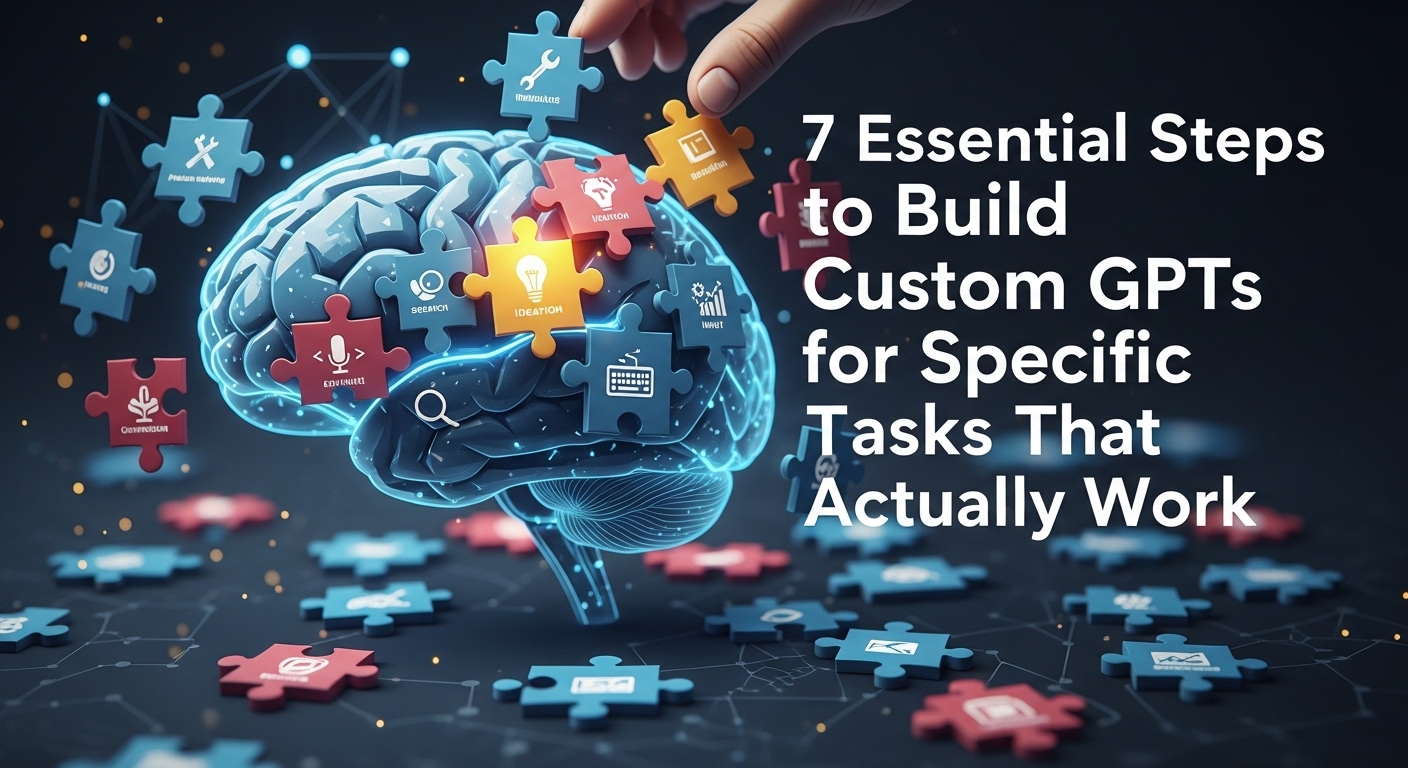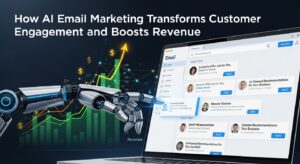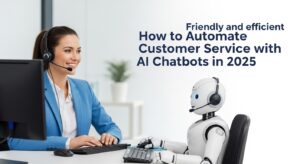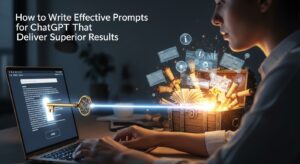Building custom GPTs for specific tasks has become one of the most powerful ways to leverage artificial intelligence for targeted business solutions. Whether you’re looking to automate customer service, create specialized content generators, or develop domain-specific assistants, understanding how to build custom GPTs effectively can transform your workflow and productivity.
In this comprehensive guide, we’ll explore the essential steps, strategies, and best practices for creating GPTs that excel at specific tasks rather than being generalist tools.
What Are Custom GPTs and Why Build Them?
Custom GPTs are specialized versions of large language models that have been fine-tuned, configured, or prompted to excel at particular tasks. Unlike general-purpose AI models, these specialized systems focus on specific domains, workflows, or use cases.
Key Benefits of Custom GPT Development
Building custom GPTs offers several compelling advantages:
- Enhanced accuracy for domain-specific tasks
- Consistent output quality aligned with your requirements
- Reduced need for extensive prompting on each interaction
- Integration capabilities with existing workflows
- Scalable automation for repetitive tasks
Understanding Different Approaches to Build Custom GPTs
Before diving into the development process, it’s crucial to understand the various methods available for GPT customization. Each approach offers different levels of complexity, cost, and effectiveness.
Method 1: Prompt Engineering and Configuration
The most accessible way to build custom GPTs involves sophisticated prompt engineering and system configuration. This approach doesn’t require technical expertise in machine learning but demands deep understanding of how language models respond to different instructions.
Advantages:
- Low cost and quick implementation
- No technical ML background required
- Easy to iterate and improve
Limitations:
- Limited by the base model’s capabilities
- May require extensive prompt optimization
- Less consistent than fine-tuned models
Method 2: Fine-Tuning Existing Models
Fine-tuning involves training a pre-trained model on your specific dataset to improve performance for particular tasks. This method offers better performance but requires more resources and expertise.
When to choose fine-tuning:
- You have substantial domain-specific data
- Consistent output format is critical
- Budget allows for computational resources
- Long-term deployment is planned
Method 3: Retrieval-Augmented Generation (RAG)
RAG systems combine language models with external knowledge bases, allowing your custom GPT to access up-to-date information and specialized knowledge not present in the base model.
This approach works particularly well for:
- Knowledge-intensive tasks
- Situations requiring current information
- Domain-specific question answering
- Document analysis and summarization
Step-by-Step Guide: How to Build Custom GPTs
Step 1: Define Your Specific Task Requirements
The foundation of successful custom GPT development lies in clearly defining what you want your model to accomplish. This step determines every subsequent decision in your development process.
Essential questions to answer:
- What specific problem will your GPT solve?
- Who is your target user base?
- What inputs will the system receive?
- What outputs should it generate?
- How will success be measured?
Create a detailed specification document that includes:
Component | Description | Example |
Task Definition | Clear statement of the primary function | “Generate technical blog posts for SaaS companies” |
Input Format | Structure and type of user inputs | “Topic keywords, target audience, word count” |
Output Requirements | Desired format and characteristics | “1500-word articles with SEO optimization” |
Success Metrics | How performance will be evaluated | “Engagement rate, SEO ranking, user satisfaction” |
Step 2: Gather and Prepare Training Data
Quality data forms the backbone of effective custom GPT development. Whether you’re using prompt engineering or fine-tuning, having relevant examples and training materials is crucial.
Data collection strategies:
- Internal sources: Existing documents, communications, and workflows
- Public datasets: Industry-specific corpora and academic resources
- Synthetic generation: Using existing AI tools to create training examples
- User-generated content: Feedback and examples from intended users
Data preparation best practices:
- Ensure data quality through careful review and validation
- Maintain consistency in format and style across examples
- Include edge cases and challenging scenarios
- Balance your dataset to avoid bias toward specific patterns
- Document your data sources for transparency and compliance
Step 3: Choose Your Development Platform
The platform you select for building custom GPTs significantly impacts your development process, capabilities, and ongoing maintenance requirements.
Popular platforms for custom GPT development:
OpenAI GPT Builder:
- User-friendly interface for beginners
- Built-in hosting and deployment
- Limited customization options
- Good for simple, conversational applications
Hugging Face Transformers:
- Extensive model library and tools
- Open-source flexibility
- Requires more technical expertise
- Excellent for research and experimentation
Google Vertex AI:
- Enterprise-grade infrastructure
- Strong integration with Google Cloud services
- Professional support and SLAs
- Higher cost but better scalability
Custom Infrastructure:
- Maximum control and customization
- Significant technical requirements
- Highest development and maintenance costs
- Best for large-scale, specialized applications
Step 4: Design Effective Prompting Strategies
Even when building custom GPTs through fine-tuning, prompt design remains crucial for optimal performance. Well-crafted prompts serve as the interface between users and your specialized model.
Core prompting principles for custom GPTs:
- Specificity and Context: Provide clear, specific instructions that leave little room for misinterpretation. Include relevant context that helps the model understand the task’s requirements and constraints.
- Example-Based Learning: Incorporate high-quality examples within your prompts to demonstrate the desired output format and quality. This technique, known as few-shot learning, significantly improves performance.
- Role Definition: Establish a clear role or persona for your custom GPT. This helps maintain consistency and ensures the model responds appropriately to different scenarios.
- Iterative Refinement: Continuously test and refine your prompts based on actual usage patterns and user feedback. Keep detailed records of prompt versions and their performance metrics.
Step 5: Implement Quality Control and Testing
Building reliable custom GPTs requires systematic testing and quality assurance processes. This step often determines the difference between a prototype and a production-ready solution.
Testing framework components:
Functional Testing:
- Verify core functionality across different input types
- Test edge cases and unusual scenarios
- Validate output format consistency
- Ensure appropriate handling of invalid inputs
Performance Testing:
- Measure response times and system throughput
- Test under various load conditions
- Monitor resource usage and optimization opportunities
- Evaluate scalability characteristics
User Acceptance Testing:
- Gather feedback from actual intended users
- Test real-world usage scenarios
- Validate that outputs meet business requirements
- Identify usability issues and improvement opportunities
Step 6: Deploy and Monitor Your Custom GPT
Successful deployment of custom GPTs requires careful planning for infrastructure, monitoring, and ongoing maintenance. The deployment strategy you choose should align with your usage patterns and business requirements.
Deployment considerations:
Infrastructure Requirements:
- Computational resources for inference
- Storage for models and data
- Network bandwidth and latency requirements
- Security and compliance considerations
Monitoring and Analytics: Implement comprehensive monitoring to track performance, usage patterns, and potential issues:
- Performance metrics: Response time, accuracy, throughput
- Usage analytics: User interactions, popular features, failure rates
- Quality metrics: User satisfaction, output relevance, task completion rates
- System health: Resource utilization, error rates, availability
Maintenance Planning:
- Regular model updates and retraining schedules
- Data refresh and quality monitoring procedures
- Security patching and vulnerability management
- User feedback integration and improvement cycles
Step 7: Optimize and Scale Your Custom GPT Solution
The final step involves continuous optimization and scaling to meet growing demands and improving performance over time.
Optimization strategies:
Model Performance:
- A/B testing different prompt variations
- Fine-tuning based on usage data and feedback
- Implementing caching strategies for common queries
- Optimizing inference speed and resource usage
User Experience:
- Streamlining interaction flows
- Improving error handling and user guidance
- Adding features based on user requests
- Enhancing integration with existing tools and workflows
Advanced Techniques for Custom GPT Development
Ensemble Methods and Model Combination
For complex tasks, combining multiple specialized models can yield better results than relying on a single custom GPT. This approach allows you to leverage different models’ strengths while mitigating individual weaknesses.
Implementation strategies:
- Sequential processing: Route requests through multiple specialized models
- Parallel processing: Combine outputs from multiple models for comprehensive responses
- Conditional routing: Direct queries to the most appropriate specialized model based on content analysis
Integration with External Systems
Modern custom GPT applications rarely operate in isolation. Successful implementations often integrate with existing business systems, databases, and APIs to provide comprehensive solutions.
Common integration patterns:
- Database connectivity for real-time data access
- API integrations with business systems and third-party services
- Workflow automation through platforms like Zapier or custom orchestration
- User authentication and authorization systems
Common Challenges and Solutions When Building Custom GPTs
Challenge 1: Inconsistent Output Quality
Problem: Custom GPTs sometimes produce outputs that vary significantly in quality or format, making them unreliable for production use.
Solutions:
- Implement robust prompt engineering with clear examples
- Use output parsers to enforce consistent formatting
- Add validation layers to catch and correct problematic outputs
- Establish feedback loops for continuous improvement
Challenge 2: Limited Domain Knowledge
Problem: Base models may lack specialized knowledge required for specific industries or technical domains.
Solutions:
- Implement RAG systems to access current, specialized information
- Fine-tune models on domain-specific datasets
- Create comprehensive knowledge bases and documentation
- Partner with domain experts for training data creation and validation
Challenge 3: Scalability and Performance Issues
Problem: Custom GPTs may struggle to maintain performance under high load or with complex queries.
Solutions:
- Implement efficient caching strategies
- Use load balancing and horizontal scaling
- Optimize model architecture for specific use cases
- Consider hybrid approaches combining different model sizes for different query types
Measuring Success: KPIs for Custom GPT Projects
Establishing clear success metrics is essential for evaluating and improving your custom GPT implementation.
Technical Performance Metrics
Metric | Description | Target Range |
Response Time | Average time to generate responses | < 3 seconds |
Accuracy Rate | Percentage of correct or acceptable outputs | > 90% |
Uptime | System availability percentage | > 99.5% |
Error Rate | Percentage of failed requests | < 1% |
Business Impact Metrics
- User adoption rates and engagement levels
- Task completion efficiency improvements
- Cost reduction compared to previous solutions
- User satisfaction scores and feedback quality
Quality Assessment Metrics
- Output relevance to user queries and context
- Consistency in tone, format, and quality
- Adherence to brand guidelines and requirements
- Safety and compliance with relevant regulations
Future Trends in Custom GPT Development
The landscape of custom GPT development continues evolving rapidly, with several emerging trends shaping the future of this technology.
- Multimodal Capabilities: Future custom GPTs will increasingly handle multiple input types including text, images, audio, and video, enabling more comprehensive and versatile applications.
- Edge Deployment: Smaller, specialized models optimized for edge deployment will enable custom GPT applications in resource-constrained environments and privacy-sensitive scenarios.
- Automated Model Development: Tools for automated prompt optimization, data curation, and model selection will make custom GPT development more accessible to non-technical users.
Getting Started with Your Custom GPT Project
Ready to build custom GPTs for your specific needs? Here’s your immediate action plan:
- Define your use case clearly and document requirements
- Start with prompt engineering using existing platforms
- Collect and organize relevant training data
- Create a minimum viable product for initial testing
- Gather user feedback and iterate quickly
- Scale gradually based on proven value and user adoption
Building effective custom GPTs requires patience, experimentation, and continuous learning. Start with simple implementations, focus on user value, and gradually expand capabilities based on real-world usage and feedback.
The investment in learning how to build custom GPTs pays dividends through improved efficiency, better user experiences, and competitive advantages in an increasingly AI-driven world. Whether you’re automating routine tasks or creating innovative new services, custom GPTs offer powerful capabilities for organizations ready to embrace specialized AI solutions.
For additional resources and tools to support your custom GPT development journey, explore the OpenAI documentation, Hugging Face model hub, and Google AI development guides. These platforms provide extensive documentation, example implementations, and community support to accelerate your development process.











